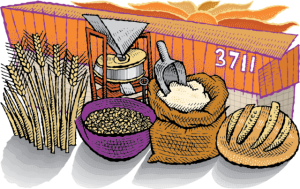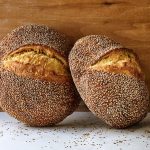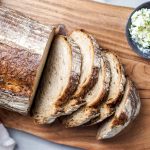Great bread plays a crucial role in making Zingerman’s Delicatessen sandwiches oh-so-cravable, and our friends and partners at Zingerman’s Bakehouse are relentless in their work to continuously improve those lovely loaves with freshly milled whole grains. And they don’t stop with their famous bread. Other favorites such as Magic Brownies, Sour Cream Coffee Cake, Big O Oatmeal Raisin Cookies and more are among the many treats Bakehouse bakers keep working at perfecting. In 2018 Zingerman’s Bakehouse took on an ambitious project, installing a stone mill and grinding many of their own grains and flours in house. Today the fruits of that labor can be enjoyed all over the Deli, from the freshly milled flour used in the Jewish rye and country miche breads, to their brownies and pie crusts. It has upped the flavor anty on so many of our beloved Bakehouse favorites.
From Zingerman’s Bakehouse: 7 Reasons We Like Freshly Milled Whole Grains
1. FUN & FLAVOR IS ALWAYS FIRST
There are a number of reasons that we’re so focused on freshly milled flour, but having fun and boosting flavor are at the top of the list—we want to make food that tastes great and enjoy doing it! Freshly milled flour results in more flavorful, nuanced breads and pastries, with more intense aromas (which is important, as smell plays a dominant role in our perception of flavors!) and even more intense colors. Also, since the oils of the grain’s germ (more on this later) are included in the fresh flour, the resulting breads and pastries are often relatively more tender (think about how the addition of a fat, like oil or butter can make for more tender baked goods). Milling our own flours also gives us an opportunity to play with our food, so to speak. We can create new culinary experiences with the wide spectrum of grains that are out there. We embrace baking with a sense of adventure, while seeking bigger flavors!
2. FRESHNESS IS VITAL
This one is pretty self-explanatory…but we’re going to talk about it anyway! An easy comparison is coffee: Would you rather have a cup of coffee made from freshly ground beans or one from beans ground months ago? Fresh, right? We believe the same goes for flour—fresh is better. And freshness doesn’t just apply to the flour, when properly made, breads and pastries made with freshly milled flours will stay fresh longer thanks to the natural oils present in the flour.
3. CHOCK-FULL OF NUTRIENTS
First, a brief grain anatomy overview. When we receive grains ready for milling, there are 3 basic parts to know about: the bran, the germ, and the endosperm. The bran is high in fiber, has a good amount of proteins, and enzymes that help with digestion. The germ is the smallest part of the kernel, but it contains the highest density of nutrients—mostly fatty acids and a lot of vitamin E. The endosperm is the largest part of the kernel, it’s primarily starch and serves as the food for the plant—this is the only part you get with commercial white flour.
Compare that to stone-ground flour, which crushes the whole grain kernel—the bran, the germ, and the endosperm—releasing all of the nutritious vitamins, minerals, and oils into the flour. This is more complete and as nature designed it—a whole food. We can use that flour as is (whole grain flour), or we can sift out some of the bran (high-extraction or ‘bolted’ flour) to varying degrees, which is somewhere between a whole grain flour and a white flour. The beauty of freshly stone-milled flour is that even if some of the bran is sifted out for a high-extraction flour, the oils of the germ have still been rubbed into the white, starchy portion of the flour, resulting in a relatively more flavorful and nutritious “whitish” flour, that still performs well and tastes delicious.
Psst: It’s no coincidence that the first point of our 2023 vision for the bakery is: “We are bringing more flavor, freshness, and nutrition to flours—milling our own grains.”
4. DEDICATED TO GREAT INGREDIENTS
We always want to use great ingredients—they provide the best flavor. We also want to know as much about our ingredients as possible: where they’re coming from, how they were grown or produced, and who is doing the growing or producing. And whenever possible, we opt for locally-sourced, sustainably-grown, and organic ingredients.
5. LESS IS OFTEN MORE
We’re focusing on food waste reduction in our bakery in novel and unexpected ways, and not removing and wasting (the most flavorful and nutritious) part of the grains we use is a nice added bonus for doing something we already believe has a lot of value. You might say it’s like not peeling the grains.
 6. TIED TO TRADITIONAL METHODS
6. TIED TO TRADITIONAL METHODS
We believe in preserving traditional baking methods and recipes, and stone milling our own flour right before we’re going to use it is bringing back an old tradition to our baking. Before the middle ages in western countries and still today in some parts of the world, people mill(ed) all of their grain at home, by hand with simple grinding stones. Then milling became industrialized and stone mills were an important part of communities—families and farmers would bring in their grain to the local mill to have it milled. We look forward to supporting this tradition by creating products made with freshly-milled flour, as well as by offering home mills, grain berries, and freshly-milled flours in our Bakeshop.
7. CONNECTING TO COMMUNITY
Food is often known for bringing people together. Sourcing local whole grains to mill and bake with brought us even closer to our community. We have been introduced to many other seekers of great food and keepers of tradition like Megan Goldenberg from Macon Creek Malthouse, The Luckhardt family of farmers, the Wilken family at Janie’s Mill, Bill Koucky of Grand Traverse Culinary Flours, Michigan State University Extension, Nature Nurture, The Andersons, Molly Breslin of Breslin Farms, and many more. In our own small way, we can improve the local food system around us and spread that joy to others.
Milling is giving us something new to share with home bakers who are already enjoying our baking classes and cookbook recipes. We’re learning right alongside them about the benefits of whole grains as we invite home milling experts and other speakers from around the country. We’re also offering our freshly milled flour for sale for them to use at home. After all, in ancient times the first home activity to be centralized was milling, followed by baking. We love bringing back old traditions and feel honored to mill a little and bake a lot for our community.




